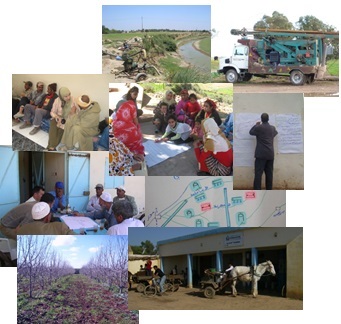Soukaina Hakkou, Nadia Machouri, Mohamed Sabir
DOI: https://doi.org/10.60569/9-a6
Numéro 9, mai 2023
Résumé
Dans la région Nord-Est du Royaume du Maroc, la truffe constitue une ressource naturelle importante. En effet, les habitants collectent ce produit saisonnier pour diversifier leurs revenus. Cependant, et malgré son importance, la filière des truffes dans la région n’a pas connu de projet de développement réussi. L’objectif de ce travail est d’étudier l’impact socio-économique de la collecte des truffes dans cette région qui comprend les Hauts Plateaux de l’Oriental, les plaines pastorales de l’Oriental, la Haute Moulouya et une partie du Tafilalet. La méthodologie suivie a été basée sur une analyse documentaire, des prospections du terrain, des enquêtes, des interviews et des ateliers avec les différents intervenants. Pendant la saison de production et durant les bonnes années, la quasi-totalité de la population participe à la collecte. La quantité collectée varie de quelques kilogrammes à l’amont (collecteurs) à quelques tonnes à l’aval (grossistes). Elle est fortement handicapée par la variabilité de la pluviométrie. La production est essentiellement exportée (pays du Moyen Orient). Le prix de vente varie selon la demande et la qualité du produit. Il est de 20 à 70 MAD/kg pour la truffe rouge et de 100 à 300 MAD/kg pour la truffe blanche pour les collecteurs. La filière, actuellement anarchique, profite plus aux intermédiaires et encore plus aux grossistes. Ces derniers vendent le produit 2 à 3 fois son prix d’achat. Des tentatives de gestion de la production initiées par le département de l’agriculture ont échoué à cause de l’instabilité de la production et des conflits locaux. La valorisation de cette ressource passe nécessairement par l’organisation et la réglementation de la filière. La recherche scientifique peut aider à innover en termes de valorisation et de gestion.
فرص وإكراهات التنمية السوسيو-اقتصادية لقطاع الكمأة في شمال شرق المغرب
ملخص
تشكل الكمأة (الترفاس) موردا طبيعيا مهما في المنطقة الشمالية الشرقية من المملكة المغربية. في الواقع، يتجه السكان لجمع هذا المنتوج الموسمي لتنويع دخلهم. ومع ذلك، وعلى الرغم من أهميته، لم يعرف قطاع الكمأة في المنطقة مشاريع تنمية وتطوير ناجحة. يهدف هذا العمل إلى دراسة التأثير السوسيو-اقتصادي لجمع الكمأة في هذه المنطقة التي تشمل الهضاب العليا والسهول الرعوية الشرقية، وملوية العليا وجزءا من تافيلالت. اعتمدت المنهجية المتبعة على التحليل الوثائقي والمسوحات الميدانية والمقابلات وورش العمل مع مختلف المتدخلين في القطاع. خلال موسم الإنتاج وفي السنوات الجيدة، يشارك الجميع في عملية الجمع. تتراوح الكمية التي يتم جمعها من بضع كيلوغرامات فيما يخص الجامعين إلى بضعة أطنان فيما يخص تجار الجملة. حيث تتأثر بشكل كبير بالتغايرية المطرية. يتم تصدير الإنتاج بشكل أساسي (دول الشرق الأوسط). يختلف سعر البيع حسب الطلب وجودة المنتوج. إذ يتراوح ما بين 20 إلى 70 درهم / كجم للكمأة الحمراء و 100 إلى 300 درهم / كجم للكمأة البيضاء بالنسبة للجامعين. عشوائية القطاع تجعل المستفيد الأكبر هم الوسطاء وأكثر منهم تجار الجملة اللذين يبيعون المنتوج مقابل 2 إلى 3 أضعاف سعر الشراء. قامت إدارة الفلاحة في المنطقة بمجموعة من المحاولات قصد تدبير الإنتاج، ولكنها تعرضت للفشل بسبب عدم استقرار الإنتاج والصراعات المحلية. تثمين هذا المورد ينطوي بالضرورة على تنظيم وتقنين القطاع. يمكن أن يساعد البحث العلمي في الابتكار من حيث التثمين والتدبير.
الكلمات المفتاحية: المغرب، منطقة الشمال الشرقي، قطاع الكمأة، المتدخلون، الأثار الاجتماعية والاقتصادية.
Constraints and opportunities for the socio-economic development of the truffle value chain in north-eastern Morocco
Summary
In the north-east of Morocco, truffles are an important natural resource. Inhabitants collect this seasonal product to diversify their income. However, despite its importance, the truffle value chain has not been successfully developed in the region. The aim of this study is to examine the socioeconomic impact of truffle collection in this region, which includes the Oriental High Plateaux, the Oriental pastoral plains, the Upper Moulouya and part of Tafilalet. The methodology used was based on documentary analysis, field surveys, interviews and workshops with the various stakeholders. During the production season and in rainy years, almost the entire population takes part in truffle collection. The quantity collected varies from a few kilograms at the beginning of the value chain (collectors) to a few tons that are handled by wholesalers. The whole value chain is highly vulnerable to rainfall variability. Production is mainly exported to Middle Eastern countries. The selling price varies according to demand and product quality. It ranges from 20 to 70 MAD/kg for red truffles and 100 to 300 MAD/kg for white truffles for collectors. The truffle value chain, which is currently anarchic, mainly benefits to intermediaries and even more so to wholesalers. The latter sell the product for 2 to 3 times its purchase price. Attempts by the Department of Agriculture to manage production have failed due to the instability of production and local conflicts. To make the most of this resource, the value chain needs to be organised and regulated. Scientific research can help innovate in terms of development and management.
Key words : Morocco, North-East region, Socio-economic impact, Stakeholders, Truffle industry
